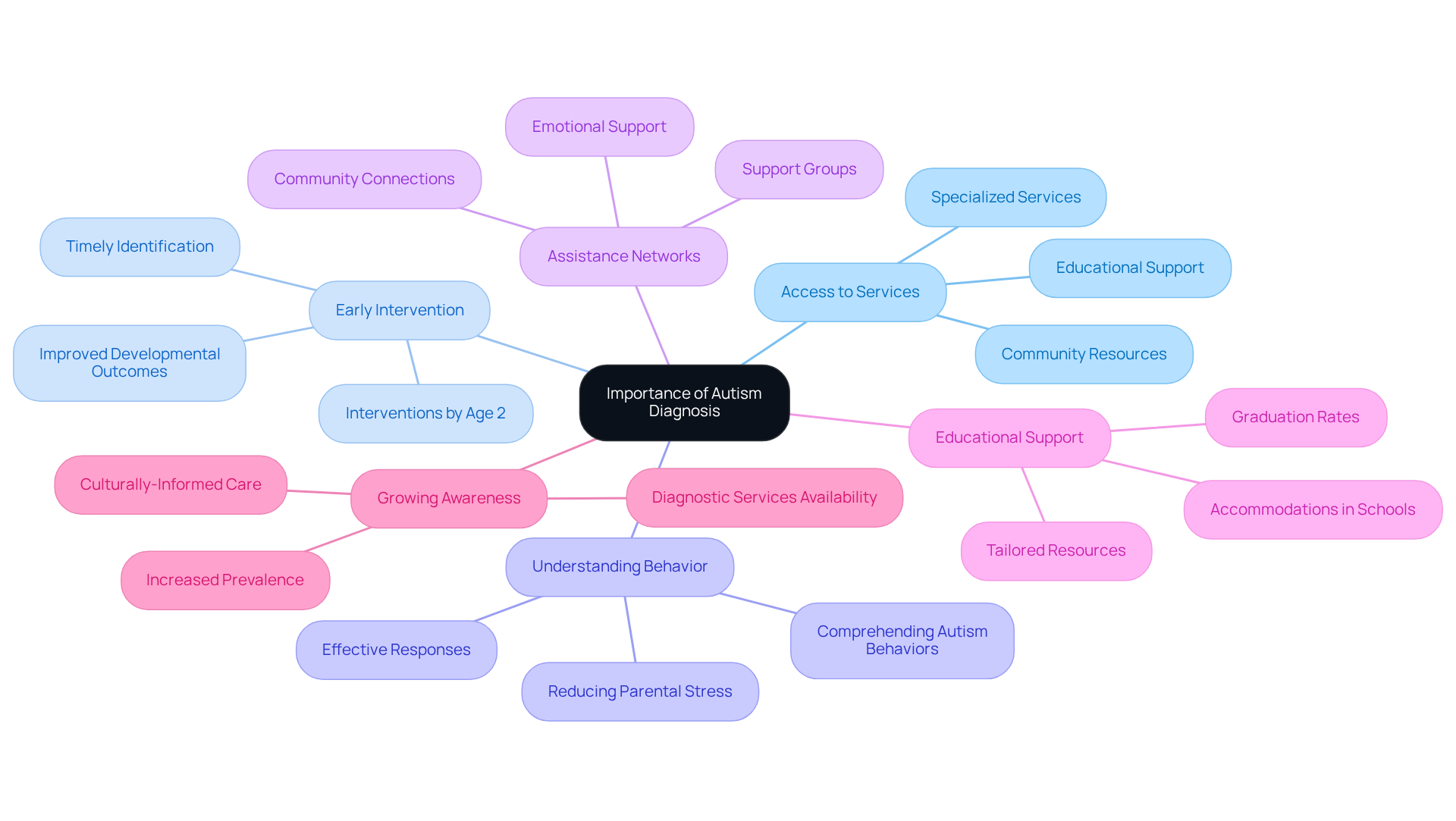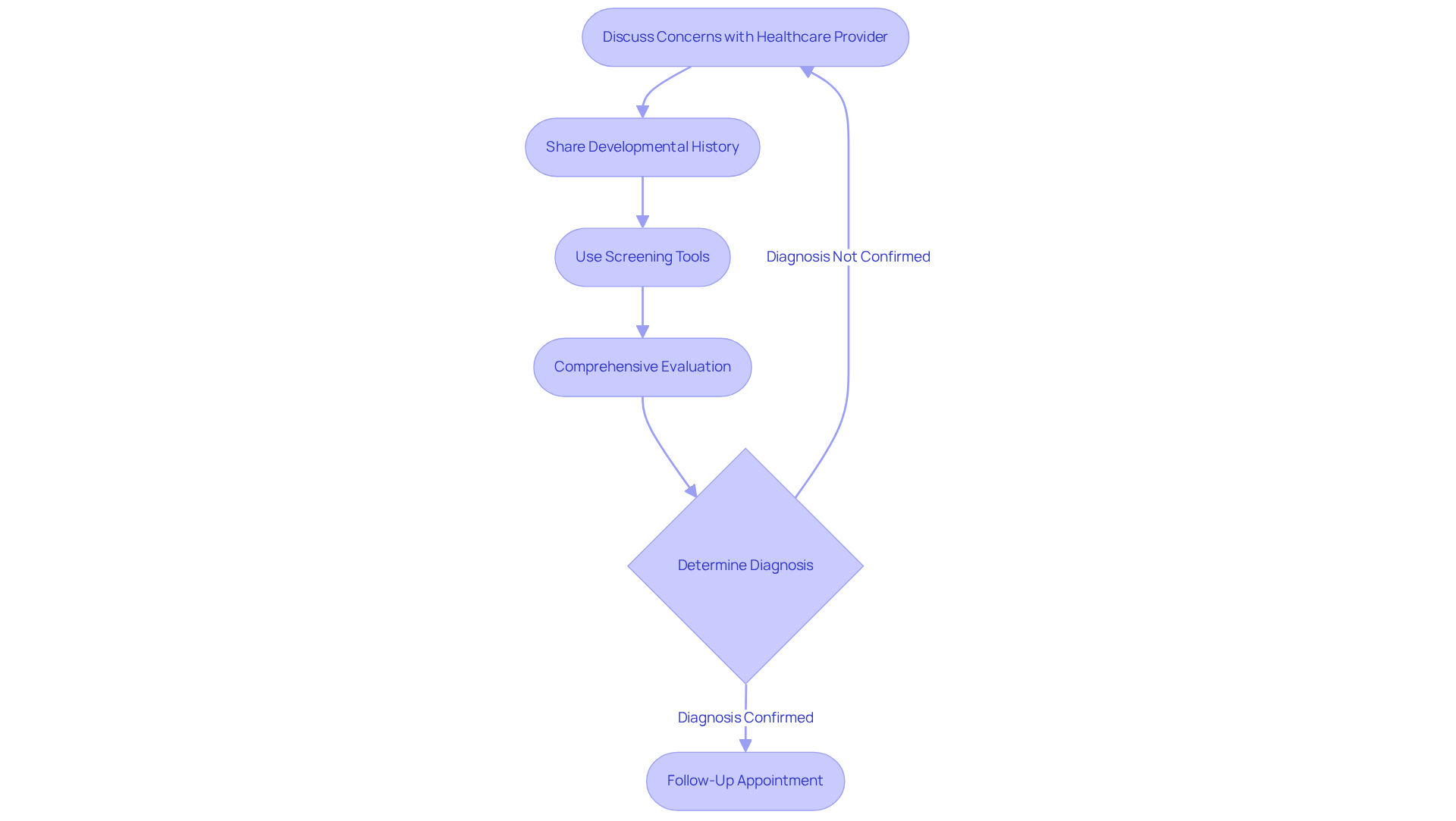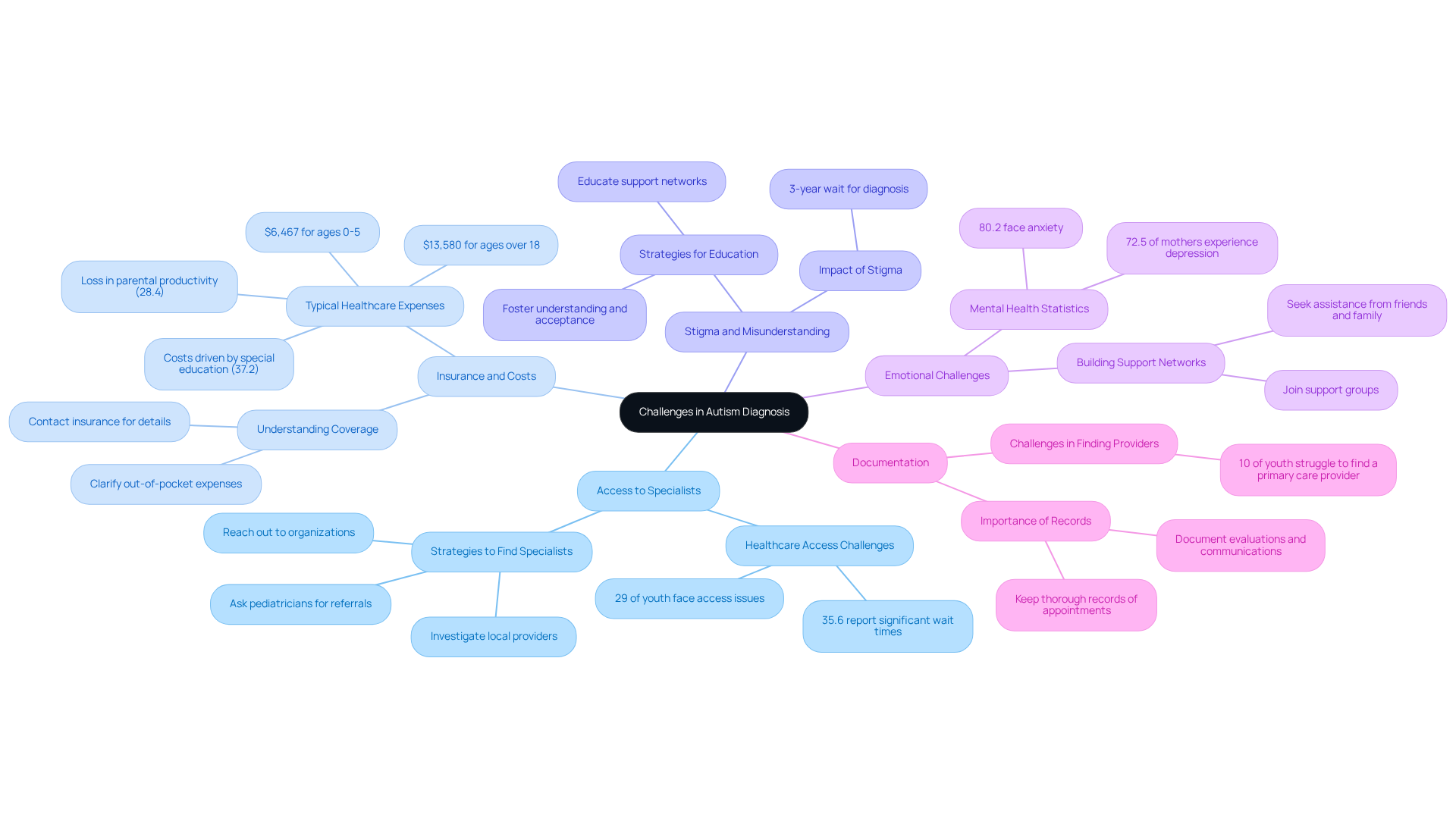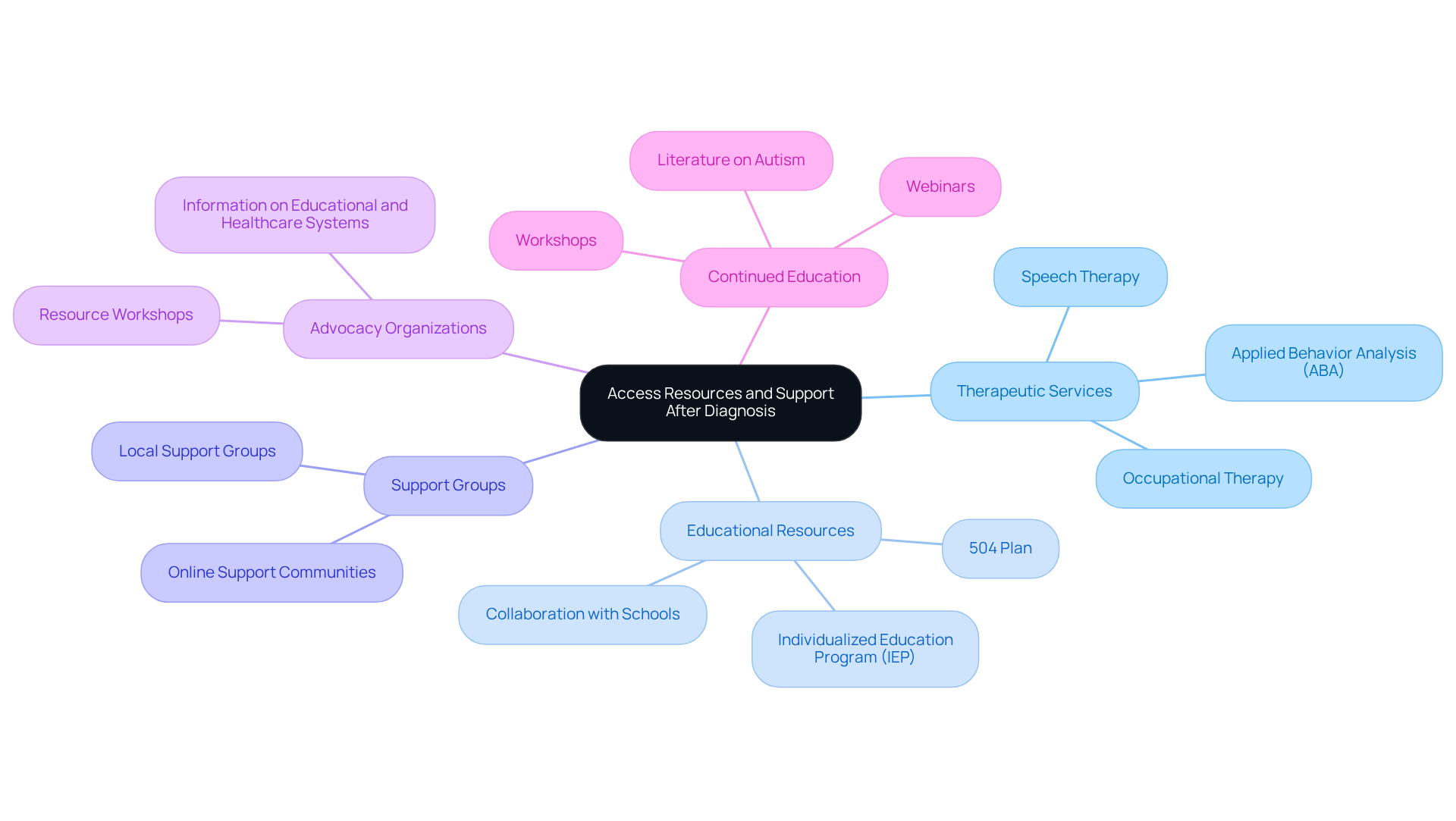Overview
Navigating the journey to obtain an autism diagnosis can feel overwhelming, but understanding the key steps involved can provide clarity and reassurance. This process includes:
- Consulting with healthcare providers
- Undergoing comprehensive assessments
- Engaging in follow-up discussions to explore the resources available
Early diagnosis is crucial, as it opens the door to specialized services, helps in understanding behaviors, and significantly improves long-term outcomes. By identifying autism in a timely manner, we can enhance the support for individuals on the autism spectrum, ensuring they receive the understanding and care they deserve. Remember, you are not alone in this journey; there are resources and communities ready to help you every step of the way.
Introduction
Navigating the journey toward an autism diagnosis can be overwhelming for many families, filled with uncertainty and numerous questions. Recognizing the significance of this diagnosis is essential, as it unlocks access to vital services, early interventions, and a supportive community tailored to individual needs. Yet, the road to obtaining a formal diagnosis is often riddled with obstacles, from finding specialists to confronting stigma. This leaves many families pondering: how can they effectively navigate this intricate process and ensure their loved ones receive the support they truly deserve?
Understand the Importance of an Autism Diagnosis
An autism assessment is essential for getting an autism diagnosis, which helps in understanding and addressing the unique needs of individuals on the spectrum. It offers clarity and creates opportunities for various resources and assistance systems. Here are some key reasons why obtaining a diagnosis is important:
- Access to Services: A formal diagnosis allows families to access specialized services, including educational support, therapy, and community resources tailored to their child's needs. This access is crucial, as studies indicate that only 21% of individuals with disabilities, including autism, are employed. This statistic highlights the pressing need for early intervention and support.
- Early Intervention: Prompt identification can lead to timely interventions that significantly enhance developmental outcomes. Research indicates that youngsters diagnosed early can benefit from therapies that improve communication and social abilities. For example, children identified by age 2 can begin receiving interventions that result in improved long-term results. Yet, the average age for getting an autism diagnosis in the U.S. remains approximately 5 years, revealing a gap in prompt identification.
- Understanding Behavior: Understanding behavior is important, and getting an autism diagnosis through an assessment helps parents and caregivers comprehend the behaviors linked to autism, enabling them to respond more effectively and compassionately. This understanding is essential, as parents of autistic children often report higher stress levels compared to those of neurotypical children.
- Assistance Networks: With an assessment, families can connect with support groups and communities that share similar experiences, fostering a sense of belonging and understanding. This connection is vital for emotional support and exchanging effective strategies for handling challenges.
- Educational Support: Schools frequently provide extra assistance and accommodations for students getting an autism diagnosis, ensuring they receive the essential resources to excel academically. Notably, 74% of autistic students in the U.S. graduate with a diploma, compared to 86% of all students, while 8% of autistic students do not finish high school. This underscores the importance of tailored educational support.
- Growing Awareness: The growing frequency of autism, currently impacting around 2.7% of youth in the U.S., highlights the importance of awareness and the necessity of getting an autism diagnosis alongside the availability of diagnostic services. In 2022, ASD prevalence among children aged 5 to 8 reached 30.3 per 1,000 children. As identification rates continue to rise, particularly among girls and minority groups, it is crucial to ensure that families receive culturally-informed care and support throughout the assessment process.

Follow the Steps to Obtain a Formal Diagnosis
Getting an autism diagnosis can feel overwhelming, but understanding the key steps can provide clarity and support. Start by discussing your concerns with a healthcare provider, such as a pediatrician or psychologist. They can guide you on the next steps and refer you to specialists if necessary.
As you embark on this journey, be prepared to share a comprehensive developmental history of the individual. This includes milestones, behaviors, and any concerns noted by caregivers or teachers, which can help paint a fuller picture of their unique needs.
Your healthcare provider may use screening tools or questionnaires to assess behavior and development. Commonly used tools include the Autism Spectrum Quotient (AQ) and the Childhood Autism Rating Scale (CARS). These assessments are vital in identifying any potential developmental disorders.
If initial screenings suggest a possible developmental disorder, a comprehensive evaluation will follow. This may involve interviews, observations, and standardized tests to assess social communication and behavior. It's important to note that 38% of individuals with ASD experience seizures, which can be relevant during this evaluation.
After the evaluation, the specialist will determine if getting an autism diagnosis is appropriate for the individual based on the diagnostic criteria for autism spectrum disorder (ASD) as outlined in the DSM-5. Ensuring that the diagnostic criteria are recorded in the assessment notes is crucial for thoroughness in this process.
Once a determination is made, it’s essential to schedule a follow-up appointment to discuss the findings and explore available resources and interventions. Healthcare experts emphasize that the diagnostic process should be informed by various sources and clinical judgment, ensuring a comprehensive understanding of each individual's unique requirements.
Statistics reveal that the average age for autism identification in the U.S. is around 5 years, with significant differences based on socioeconomic factors. For example, children from lower-income households are diagnosed at an average age of 4.7 years, while those from higher-income households are diagnosed at 5.2 years. Early identification is vital, as getting an autism diagnosis through prompt assessment can lead to improved outcomes and ensure access to necessary support services. Furthermore, just 21% of individuals with disabilities, including those with autism spectrum disorders, are in the workforce. This highlights the importance of early identification concerning future job prospects.
If you find yourself navigating this process, know that you are not alone. Sharing your experiences and seeking support can make a significant difference in your journey.

Navigate Challenges in the Diagnosis Process
Navigating the process of getting an autism diagnosis can be challenging, with various obstacles that families may encounter. It's important to recognize these challenges and explore effective strategies to overcome them, as you are not alone in this journey.
-
Access to Specialists: Finding a qualified autism specialist can feel overwhelming. Consider investigating local providers, asking for suggestions from your pediatrician, or reaching out to organizations for referrals. It's worth noting that nearly 29% of youth with developmental disorders face healthcare access challenges, and 35.6% of families report significant wait times to consult a specialist. This highlights the urgency of seeking support.
-
Insurance and Costs: Understanding your insurance coverage for diagnostic evaluations is crucial for your peace of mind. Contact your insurance provider to clarify which services are covered and any potential out-of-pocket expenses. The typical healthcare expenses for children with developmental disorders can escalate significantly, ranging from approximately $6,467 for ages 0-5 to $13,580 for those over 18 years. Additionally, costs are primarily driven by special education needs (37.2%) and loss in parental productivity (28.4%), making it essential to stay informed about your financial responsibilities.
-
Stigma and Misunderstanding: Families may encounter stigma or misconceptions about autism. Educating yourself and your support network can foster understanding and acceptance, which is vital for creating a nurturing environment. It's important to recognize that families often wait around 3 years between their initial concerns and getting an autism diagnosis, which underscores the real-world effects of stigma and misunderstanding.
The emotional challenges families face can be significant during the process of getting an autism diagnosis. Seeking assistance from friends, family, or groups for individuals on the spectrum can create a safe space to share experiences and emotions, helping to alleviate some of the emotional burdens. It's crucial to acknowledge that 72.5% of mothers of autistic children experience depressive symptoms, and 80.2% face anxiety. This highlights the importance of building a supportive network.
- Documentation: Keeping thorough records of all appointments, evaluations, and communications with healthcare providers is essential. This documentation can serve as a valuable resource for future reference and advocacy, ensuring that you have the necessary information at hand when navigating the healthcare system. Moreover, 10% of youth with developmental disorders face challenges in locating a primary care provider, emphasizing the necessity for comprehensive records in navigating healthcare systems.

Access Resources and Support After Diagnosis
Getting an autism diagnosis can be overwhelming, but accessing the right resources and support can make a significant difference in navigating the next steps effectively.
- Therapeutic Services: It's important to explore various therapeutic options, such as Applied Behavior Analysis (ABA), speech therapy, and occupational therapy. These services can directly address specific challenges your child may face and help enhance their skills.
- Educational Resources: Collaborating with your child's school is crucial. Work together to create an Individualized Education Program (IEP) or a 504 Plan, ensuring that your child receives the essential accommodations and assistance they need in the classroom.
- Support Groups: Consider joining local or online support groups for parents and caregivers. These groups provide a wonderful platform to share experiences, gain insights, and build a supportive community that understands your journey.
- Advocacy Organizations: Connecting with advocacy organizations can also be beneficial. They offer valuable resources, workshops, and information on navigating the educational and healthcare systems, empowering you to advocate for your child effectively.
- Continued Education: Finally, staying informed about autism through workshops, webinars, and literature is essential. Continuous learning can empower you to advocate effectively for your child and deepen your understanding of their unique needs.

Conclusion
Obtaining an autism diagnosis is a vital step that opens the door to understanding and supporting individuals on the spectrum. This process not only clarifies unique needs but also facilitates access to essential services, early intervention, and a supportive network that can significantly enhance quality of life. The importance of a formal diagnosis cannot be overstated, as it lays the groundwork for tailored educational support and therapeutic resources.
Throughout this journey, several key arguments highlight the multifaceted benefits of getting an autism diagnosis:
- Early identification allows for timely interventions that can improve developmental outcomes.
- Understanding behavior helps caregivers respond more effectively.
- The challenges faced—such as access to specialists, insurance complexities, and societal stigma—are significant.
- They can be navigated with the right strategies and support systems in place.
- The importance of thorough documentation and community connections emerges as vital tools for families.
Reflecting on the broader implications, it becomes evident that a proactive approach in seeking an autism diagnosis not only benefits individuals but also fosters a more inclusive society. Families are encouraged to advocate for their needs and seek out resources that empower them. By prioritizing early diagnosis and intervention, the potential for positive outcomes increases, not just for individuals with autism but for the entire community. Embracing this journey with determination and support can truly pave the way for a brighter future.
Frequently Asked Questions
Why is obtaining an autism diagnosis important?
An autism diagnosis is important because it helps in understanding and addressing the unique needs of individuals on the spectrum, providing access to specialized services, early intervention, and support networks.
What services can families access with a formal autism diagnosis?
Families can access specialized services including educational support, therapy, and community resources tailored to their child's needs.
How does early diagnosis impact developmental outcomes?
Early diagnosis allows for timely interventions that significantly enhance developmental outcomes, as research shows that children diagnosed by age 2 can benefit from therapies that improve communication and social skills.
What is the average age for obtaining an autism diagnosis in the U.S.?
The average age for getting an autism diagnosis in the U.S. is approximately 5 years, indicating a gap in prompt identification.
How does an autism diagnosis help parents and caregivers?
An autism diagnosis helps parents and caregivers understand the behaviors linked to autism, enabling them to respond more effectively and compassionately, which is crucial for managing stress levels.
What role do assistance networks play for families with an autism diagnosis?
Assistance networks allow families to connect with support groups and communities, fostering a sense of belonging and providing emotional support and effective strategies for handling challenges.
What educational support do autistic students receive?
Schools often provide extra assistance and accommodations for students with an autism diagnosis, which is essential for their academic success.
What are the graduation statistics for autistic students in the U.S.?
Approximately 74% of autistic students in the U.S. graduate with a diploma, compared to 86% of all students, while 8% of autistic students do not finish high school.
How prevalent is autism among youth in the U.S.?
Autism currently impacts around 2.7% of youth in the U.S., with prevalence rates reaching 30.3 per 1,000 children among those aged 5 to 8 in 2022.
Why is culturally-informed care important in the autism assessment process?
Culturally-informed care is crucial to ensure that families receive appropriate support throughout the assessment process, especially as identification rates rise among girls and minority groups.




